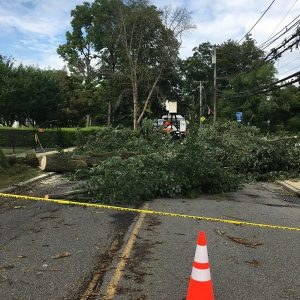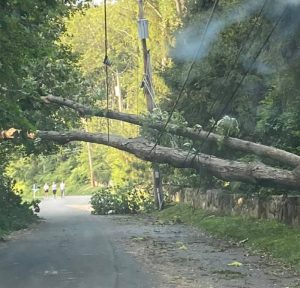County Legislators Demand Utilities ‘Must Do Better’ After Isaias Storm Response
Westchester County residents were once again at the mercy of local utility companies when the aftermath of Tropical Storm Isaias left thousands without power for several days, but representatives from Con Edison and New York State Electric & Gas assert they were prepared and acted swiftly.
Similar to years past, the Westchester County Board of Legislators on Thursday held a special meeting skewering both utility companies on their preparation, restoration and communication efforts during and after the Aug. 4 storm. Isaias resulted in thousands of downed trees and wires and nearly 200,000 power outages across the county.
During the more than two-hour meeting, representatives from both utilities insisted they were prepared for what Isaias was forecast to be, not what initially impacted the area, a similar sentiment made two years ago following the muddled response to the widespread outages inflicted by dual Nor’easters Quinn and Riley.

Officials said that while both utilities may have appeared to be prepared, their execution was ultimately flawed, with some agreeing that changes promised years ago have yet to be made. A 170-page report was issued to both companies in 2018 with recommendations on ways to improve storm response.
“Repeatedly we’ve been assured that these steps would make things better the next time, but next time has come and nothing has seemed to have changed. In fact, things may have gotten worse,” Chairman Ben Boykin (D-White Plains) said. “The people who pay the price are the residents and businesses who have no choice but to rely on companies that appear not to be able to get the job done.”
Boykin was also critical of the delay in mutual aid, pre-storm preparations and the shoddy communication efforts between utilities, customers and municipalities regarding restoration times. He added substantial structural change is necessary and both companies “must do better.”
Trish Nilsen, NYSEG’s director of emergency preparedness, said the company planned for a “significant” event in the days leading up to Isaias. She said the utility had over 700 support personnel and crews in place, but the heavy rain and wind was comparable to Superstorm Sandy.
With 350 broken poles and 2,400 downed wires, Nilsen said the damage in some areas of Westchester and Putnam counties surpassed the impacts that Sandy had on the community. She added NYSEG had crews working around the clock to restore service in a more effective and efficient way compared to prior storms.
“We developed a plan and we worked the plan and we repeated that process until the job was complete,” Nilsen said, noting that power was restored to 95 percent of customers on Aug. 9. “The company was able to quickly establish an updated estimated time of restoration due to those efforts.”
NYSEG is currently reviewing how it handled the storm to further implement best practices, Nilsen said.
While residents and officials scrutinized Con Edison in the days following the storm for its faulty efforts and miscommunication, Shakira Wilson, vice president of emergency preparedness, said the utility was prepared with mutual aid requested and additional contractor crews ready to respond.
As the storm strengthened beyond what was originally forecast, Wilson said Con Edison responded “aggressively,” flying in about 100 mutual aid workers and placing over 1,000 workers in the field. The storm ultimately resulted in nearly 330,000 customers losing power, including 125,000 in Westchester.

“The extremely strong winds caused widespread destruction,” Wilson said. “The damage was so severe that it required us to entirely rebuild sections of our system rather than just repair them.”
Power was restored to all customers by Aug. 11.
Despite the setback, Wilson assured restoration was “significantly” faster than previous years, adding that the annual $25 million used to fortify the county’s electrical system also resulted in 20 percent fewer outages. The implementation of smart meters toward the end of the year will further aid in quicker and greater accuracy in restoration efforts, she said.
In response to erroneous restoration times, Con Edison officials explained customers were wrongly notified when one of multiple points of damage were fixed. Essentially, if the power was repaired, the distribution area may have still been disconnected, resulting in a false notification going out to customers.
“We have implemented the recommendations from past storms and strengthened our system over the years to make it more resilient, but we know this is not enough,” Wilson said. “Ultimately, we are accountable for our customers, and under these types of extreme storm conditions it is clear we are not meeting our customers’ expectations.”
Lawmakers briefly discussed the possibility of burying power lines underground, implementing stronger utility poles and removing trees that sit on power lines, options that have been discussed following other significant weather events. Other suggestions included utilities investing more in hiring local personnel.
Majority Leader MaryJane Shimsky (D-Hastings-on-Hudson), along with fellow officials, also issued concern with the damage stronger storms could bring to residents and the economy if efforts are not better coordinated and executed.
“Having been through this in 2018, I have to say today, I’m really not feeling like we’ve come very far,” Legislator Catherine Parker (D-Rye) said. “If crews aren’t here as soon as the storm is over to restore power to Westchester, then that’s not good enough.”
